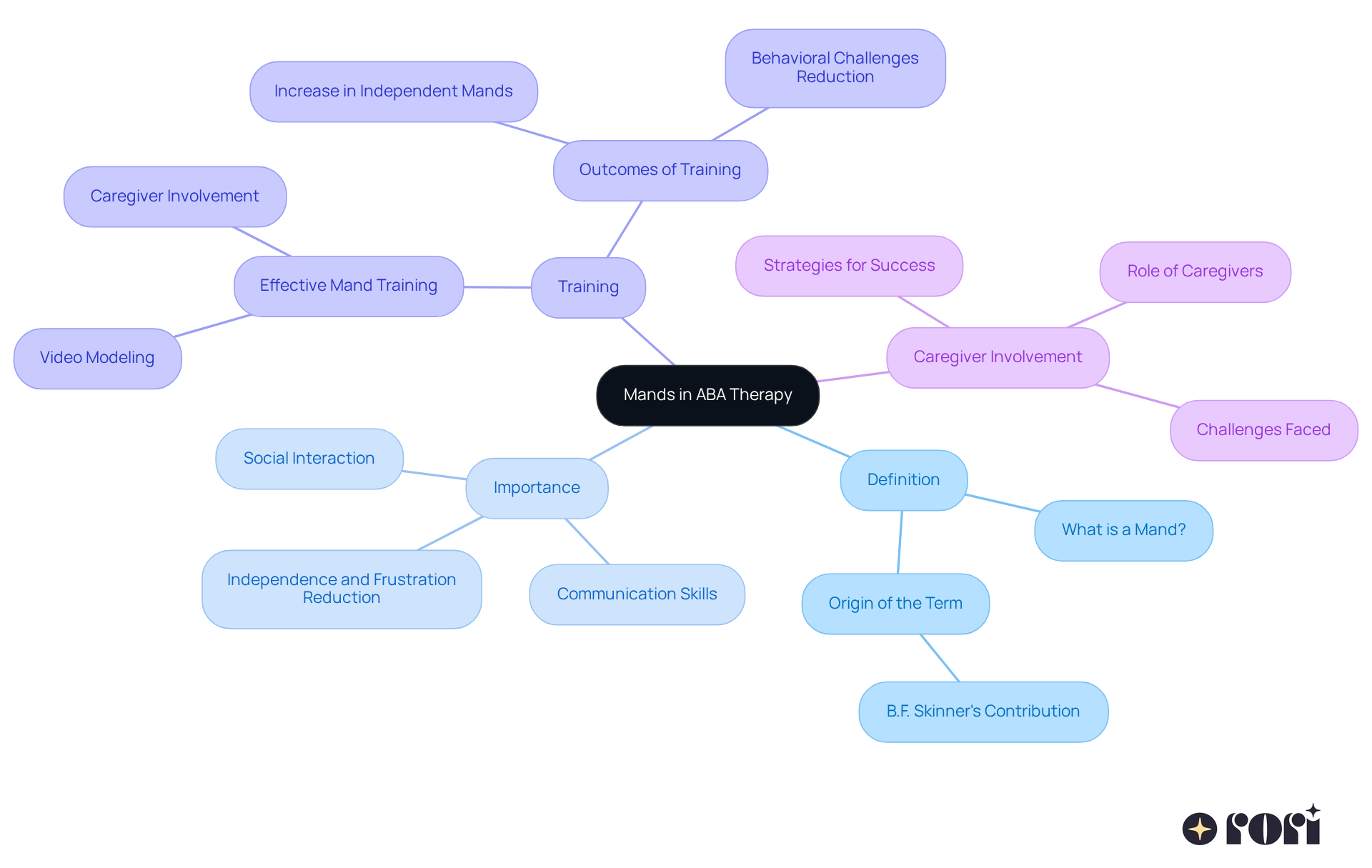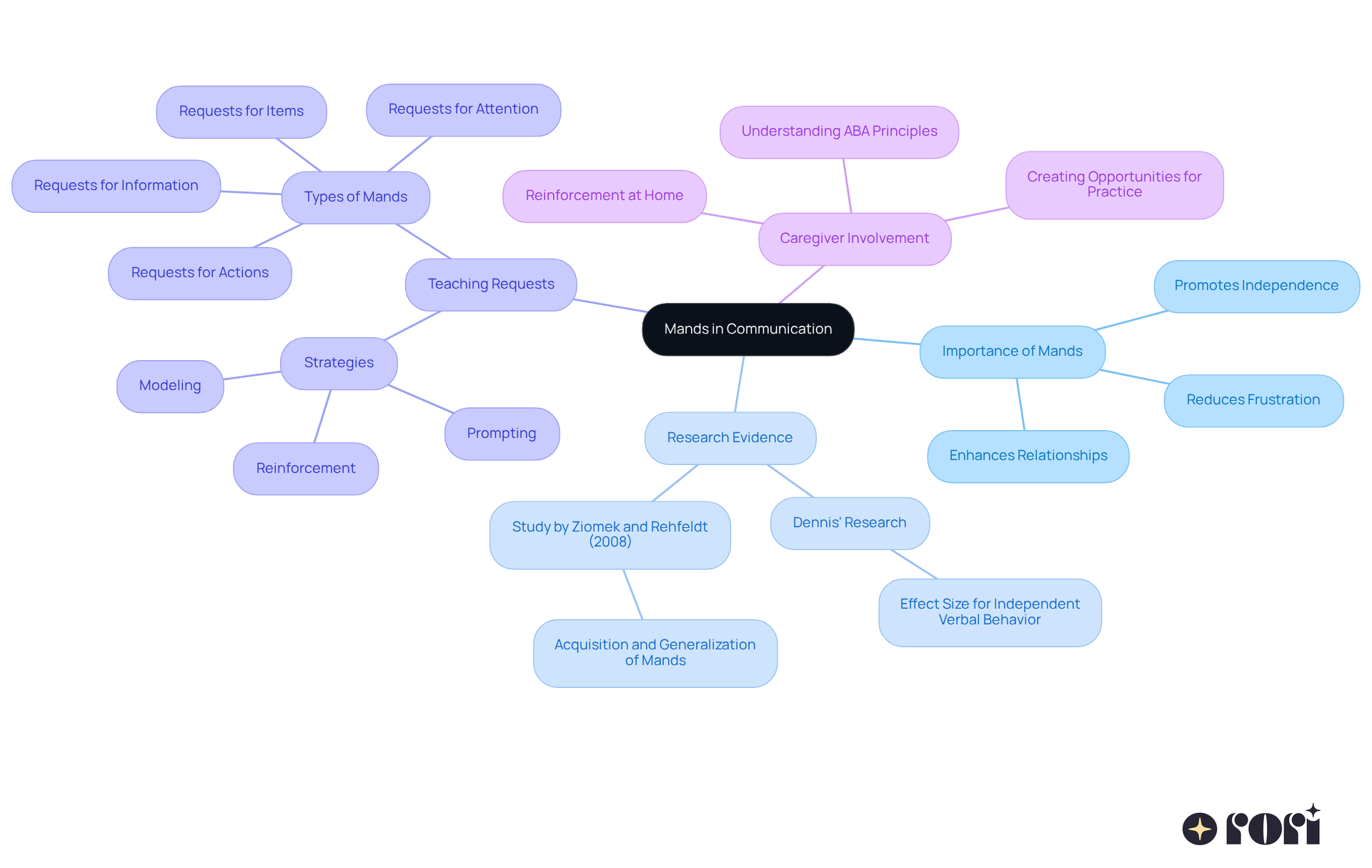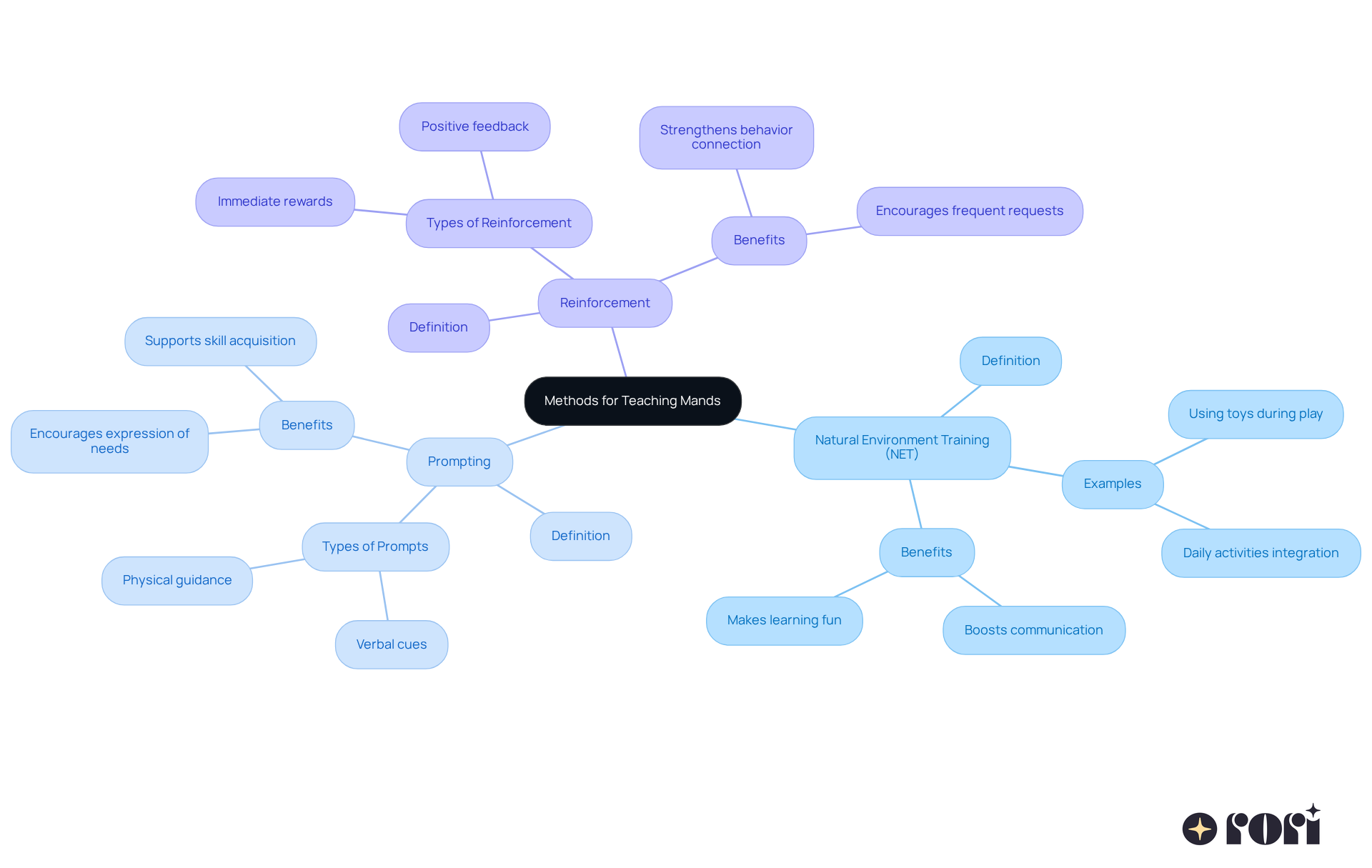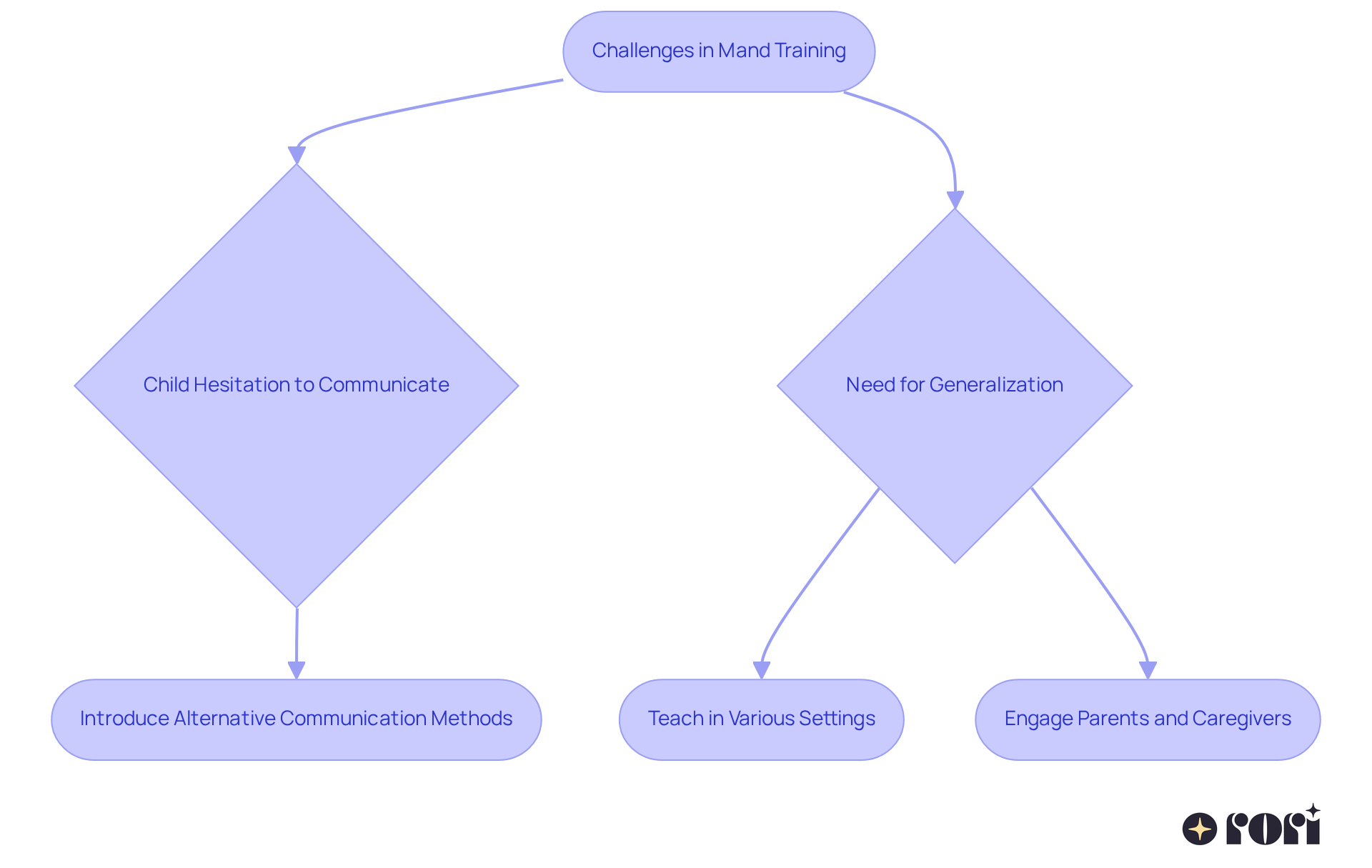Mands, in the world of ABA therapy, are a special kind of verbal behavior that act as requests or demands. They play a vital role in helping individuals, especially those with autism, express their needs and wants more effectively. 🌟
Teaching mands can truly enhance communication skills and reduce those frustrating behavioral challenges that often arise. Plus, it encourages independence and fosters social interactions! Research backs this up, showing how effective training methods and caregiver involvement can make a significant difference.
Let’s explore this together! By understanding and implementing mands, you can help create a more connected and communicative environment for your loved ones.
Understanding the nuances of communication is vital in the world of Applied Behavior Analysis (ABA) therapy, especially when we talk about a specific type of verbal behavior called mands. These requests act as a bridge for individuals, particularly those with autism, helping them express their needs and desires. This not only fosters independence but also reduces frustration.
However, while we clearly see the importance of mands, the journey to teach and reinforce them can be quite challenging. How can caregivers and therapists navigate these hurdles to unlock the full potential of mand training? Let’s explore this together and enhance communication skills!
In Applied Behavior Analysis (ABA) therapy, what are mands is a special kind of verbal behavior that serve as requests or demands. The word 'mand' comes from 'demand,' a concept introduced by B.F. Skinner when he looked into verbal behavior. Understanding what are mands is crucial for empowering individuals, especially those with autism, to express their needs and wants effectively. For example, when a child says 'juice' to ask for a drink, they’re using a mand! This way of communicating is key for helping kids become more independent and less frustrated, as it allows them to clearly express what are mands and what they need.
Research shows that effective mand training can help answer the question of what are mands and really boost interaction skills in individuals with autism. In one study, kids had a noticeable increase in independent manding, with some reaching up to 48% during maintenance checks. This improvement not only helps with better communication but also encourages social interactions and lessens behavioral challenges that come from unmet needs. Interestingly, 90% of individuals show great progress in ABA therapy when caregivers are actively involved, highlighting what are mands and how crucial caregiver participation is for successful training.
Qualified behavior analysts are vital in this process, creating personalized plans with measurable goals and evidence-based strategies tailored to each individual’s unique needs. These plans are continuously assessed and adjusted to make sure they adapt to the individual's development. This tailored support ensures that caregivers receive the essential ABA principles and strategies to enhance their child’s learning at home. Skinner pointed out the importance of understanding behavior as a form of expression, stating, 'Behavior is a form of expression, and we must listen.' This perspective highlights how crucial requests are in developing functional communication skills, which are essential for overall growth. By focusing on what are mands, caregivers and therapists can create opportunities for children to express themselves, which leads to more effective and meaningful interactions in their daily lives.
However, caregivers might face challenges when managing behaviors during mand instruction, which can impact the effectiveness of the intervention. It's important to address these challenges to maximize the benefits of understanding what are mands training. Let’s explore this together! We're here to help you every step of the way!

Understanding what are mands is vital in helping individuals with autism connect and grow. They’re not just simple requests; they reflect a young person’s ability to express what are mands and their needs. This skill is essential for building effective interactions with others. When therapists focus on teaching these requests, they can greatly enhance functional communication skills. This, in turn, helps reduce challenging behaviors like tantrums or aggression, which often stem from frustration due to communication difficulties.
Research shows that teaching requests can lead to a significant drop in these behaviors. Children learn to express their needs more appropriately. For example, a study by Ziomek and Rehfeldt (2008) highlighted how the Picture Exchange Communication System (PECS) helped kids acquire and generalize requests. This demonstrates how structured request training can be incredibly effective.
What’s more, requests can be taught in various situations, making them flexible tools that not only improve social skills but also promote independence in daily activities. When children learn to ask for items or actions, they feel empowered to engage more meaningfully with peers and caregivers. This enriches their social experiences and lessens frustration.
As B.F. Skinner pointed out, what are mands refers to a type of verbal behavior motivated by a person’s need or desire, emphasizing their foundational role in communication. It's also crucial to educate caregivers on how to reinforce mand training at home. When caregivers understand ABA principles, they can make informed choices that positively impact their child's progress, ultimately enhancing support and improving behavioral outcomes.
For instance, a caregiver who sees the importance of prompting and reinforcing requests can create opportunities for their child to practice these skills in everyday situations. This not only aids their communication development but also strengthens the bond between them. Let’s explore this together and see how we can make a difference!

Effectively teaching what are mands can be a game changer for parents and their little ones! It involves some great evidence-based strategies, like natural environment training (NET), prompting, and reinforcement. In NET, therapists create natural opportunities for children to express their wishes during play or daily activities. For instance, if a child shows interest in a toy, the therapist might hold off on giving it until the child uses a mand to ask for it, which illustrates what are mands. This approach not only boosts communication but also makes learning fun!
Prompting is another helpful tool. It can come in various forms, like verbal cues or gentle physical guidance, to encourage the child to express their needs. And let’s not forget about reinforcement! When a young learner successfully uses what are mands, providing the requested item or activity right away reinforces that behavior. This positive reinforcement strengthens the connection between the request and the outcome, creating a supportive environment where children feel encouraged to make requests more often.
Research shows that these strategies can significantly enhance communication skills. Many studies highlight impressive success rates in natural settings, showing marked improvements in children's ability to articulate their desires and needs effectively. So, let’s explore this together! We’re here to help you every step of the way!

Understanding what are mands is so important, but teaching them can come with its own set of challenges. One common hurdle is when a child hesitates to communicate verbally, often due to feelings of anxiety or low self-confidence. To help with this, therapists can introduce alternative communication methods, like picture exchange systems or sign language. These can be fantastic starting points for communication!
It’s also essential to teach requests in a variety of settings to help children generalize their skills. Engaging parents and caregivers in this journey is key. They can create everyday opportunities for understanding what are mands, reinforcing what the child learns in real-life situations. By fostering a supportive environment and using diverse teaching strategies, therapists can really boost the effectiveness of mand training. This empowers children to communicate more confidently and effectively. Let’s explore this together!

Understanding mands is so important in the world of Applied Behavior Analysis (ABA) therapy, especially when it comes to helping individuals with autism improve their communication skills. Mands are like keys that unlock the ability to express needs and desires, enabling children to share what they want and fostering greater independence. By focusing on these verbal requests, caregivers and therapists can really enhance the quality of interactions and reduce the frustration that often comes from communication barriers.
In this article, we've explored various aspects of mands, from what they are to why they matter in communication. We’ve also looked at effective teaching methods and the vital role caregivers play in mand training. Evidence-based strategies, like natural environment training and prompting, have been highlighted as great ways to teach children how to use mands. Plus, when caregivers understand and reinforce these skills, it can lead to meaningful progress in a child's communication development.
Ultimately, mands are more than just verbal requests; they’re a fundamental part of functional communication that can truly transform social interactions and improve the quality of life for individuals with autism. By prioritizing mand training and tackling the challenges that may arise, caregivers and therapists can come together to create a supportive environment that nurtures effective communication. Embracing this approach not only benefits children but also enriches relationships and fosters a deeper understanding of each other's needs. Let’s explore this journey together, and remember, we’re here to help you every step of the way!
What are mands in ABA therapy?
Mands are a type of verbal behavior in Applied Behavior Analysis (ABA) therapy that serve as requests or demands. The term 'mand' is derived from 'demand' and was introduced by B.F. Skinner in his study of verbal behavior.
Why are mands important for individuals with autism?
Mands empower individuals, especially those with autism, to express their needs and wants effectively. This form of communication helps them become more independent and less frustrated by allowing them to clearly articulate what they need.
How does mand training benefit individuals with autism?
Effective mand training can significantly improve interaction skills in individuals with autism. Research has shown that children can achieve increased independent manding, leading to better communication, enhanced social interactions, and reduced behavioral challenges stemming from unmet needs.
What role do caregivers play in mand training?
Caregiver participation is crucial for successful mand training, with studies indicating that 90% of individuals show significant progress in ABA therapy when caregivers are actively involved.
How do behavior analysts contribute to mand training?
Qualified behavior analysts create personalized plans with measurable goals and evidence-based strategies tailored to each individual's unique needs. These plans are continuously assessed and adjusted to ensure they align with the individual's development.
What challenges might caregivers face during mand instruction?
Caregivers may encounter challenges in managing behaviors during mand instruction, which can affect the effectiveness of the intervention. Addressing these challenges is essential to maximize the benefits of mand training.
What is the overall goal of focusing on mands in ABA therapy?
The goal of focusing on mands is to develop functional communication skills, which are essential for overall growth. By facilitating opportunities for children to express themselves, caregivers and therapists can foster more effective and meaningful interactions in daily life.